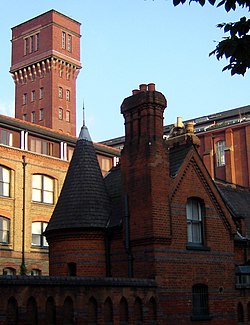This is an old revision of this page, as edited by Styrofoam1994 (talk | contribs) at 03:13, 5 February 2008 (Reverted good faith edits by Durzatwink; Only one thing was added (unreferenced) while he made mispellings and complicated the structure to make it harder to read. using TW). The present address (URL) is a permanent link to this revision, which may differ significantly from the current revision.
Revision as of 03:13, 5 February 2008 by Styrofoam1994 (talk | contribs) (Reverted good faith edits by Durzatwink; Only one thing was added (unreferenced) while he made mispellings and complicated the structure to make it harder to read. using TW)(diff) ← Previous revision | Latest revision (diff) | Newer revision → (diff)| It has been suggested that Bow Quarter be merged into this article. (Discuss) Proposed since June 2007. |

The former Bryant and May match factory in Bow, London, England, the site of the famous London matchgirls strike of 1888 is now a residential development known as the Bow Quarter.
From the mid 19th century to more than three-quarters of the way through the 20th century it was the location of the famous Bryant and May match-making operation. At one point at the turn of the two centuries it was London's largest factory.
The three acre site, acquired by William Bryant and Francis May in 1861, contained a number of factories that had once been used for the manufacture of candles, crinoline and rope but had fallen into disrepair. Assistance in adapting the site for match making was provided by John Edvard Lundström, the Swedish safety match maker.
The factory saw many famous historical events: the London matchgirls strike of 1888 started here, for example, culminating in the establishment of the first British trade union for women. A blue plaque outside the entrance commemorates the role of social pioneer and feminist Annie Besant in leading the demands for better pay and conditions.
Bryant and May were influential in fighting against the dreadful disease known as phossy jaw, caused by the white phosphorus used in the manufacture of early matches. Some of the first welfare institutions in Britain for industrial workers began on this site, including the provision of a dentist.
The factory was only finally closed in 1979, when it still employed 275 people; the work being transferred to Liverpool. At its height more than 3,000 women and girls worked at Bow.
Once again the site fell into disrepair until in 1988 developers embarked upon one of East London's first urban renewal projects.
The majority of the apartments today are housed in former factory and office buildings. Arlington for example was built as offices in 1874; Lexington and Manhattan date from the factory site redevelopment in 1911. The Victorian cottages near the entrance provided accommodation for the company directors whilst Staten was built as extra office accommodation in the late 1950s. Park Central was added in the mid 1990s.
Categories: